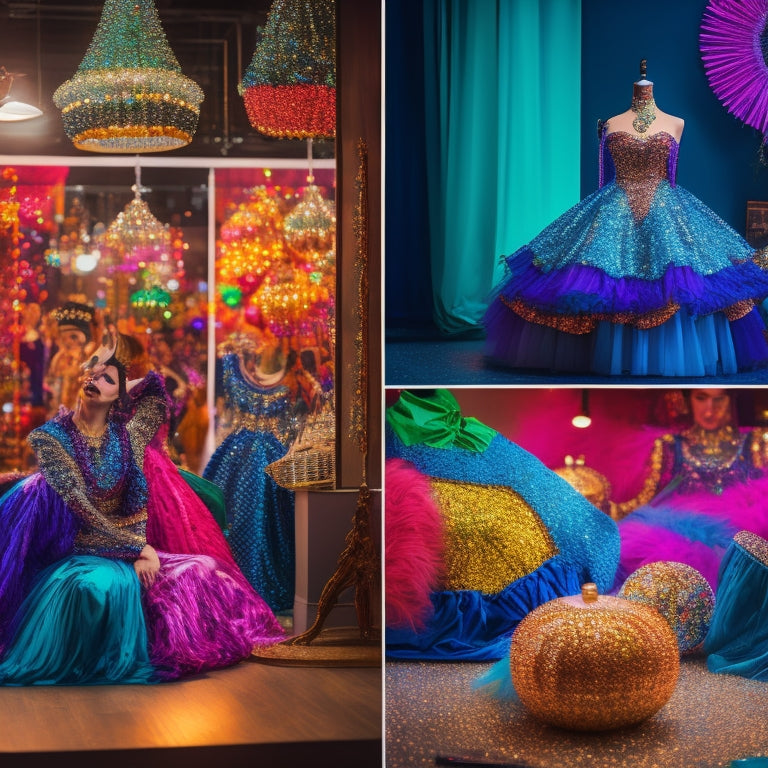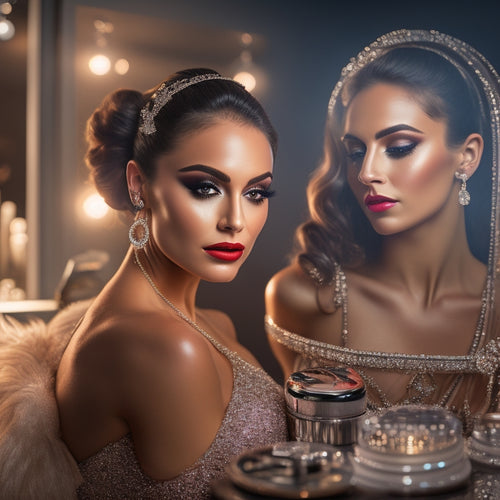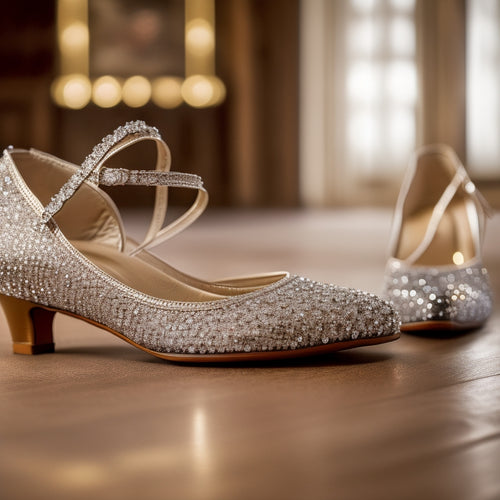
What Are the Dance Costume Design Secrets You Need to Know
Share
To design standout dance costumes, prioritize durable fabrics like spandex and nylon blends that allow for flexibility and breathability. Understand the impact of color theory; lively colors can amplify emotions and enhance your choreographed story. Don't overlook fit; your costumes should let dancers move freely without restriction. Reinforce high-stress areas with extra stitching to prevent mishaps during performances. Finally, consider budget-friendly options; thrift store treasures can inspire unique designs while supporting sustainable practices. Uncovering these secrets will raise your costume design skills even further.
What You Need to Know
- Choose durable fabrics like spandex and nylon blends to ensure costumes withstand rigorous movement and repeated performances without malfunctions.
- Utilize reinforcement techniques such as extra stitching and heavy-duty thread in high-stress areas to enhance costume longevity.
- Prioritize mobility by selecting four-way stretch fabrics and comfortable waistbands, allowing dancers to focus on technique and performance.
- Understand color theory to create visually impactful costumes that evoke emotional responses and enhance storytelling through color and texture.
- Explore thrift stores for unique, budget-friendly costume pieces, repurposing finds to support sustainable fashion and add individuality to designs.
Costume Durability for Performances
When it comes to dance costumes, choosing the right materials can make all the difference between a stunning performance and a wardrobe malfunction.
You'll want to investigate various fabric options that offer both flexibility and strength, ensuring your costume withstands the rigors of movement. Fabrics like bamboo and silk provide natural moisture-wicking properties, while also being breathable options.
Additionally, incorporating reinforcement techniques can enhance your designs, giving them the durability they need to shine on stage night after night.
Material Selection Strategies
Choosing the right materials for dance costumes is essential, as they not only influence the overall aesthetic but also determine how well the garment withstands the rigors of performance. To achieve that perfect blend of durability and style, consider lightweight yet sturdy fabrics like spandex or nylon blends. These textiles aren't only flexible and breathable, but they also allow for a freedom of movement that dancers crave.
Embracing sustainability practices in your material selection can enhance both the environment and your costume's longevity. Look for recycled fabrics or organic cotton, which offer durability without compromising your eco-friendly values.
Additionally, investigate textile innovations that provide moisture-wicking properties or UV protection; these features can be transformative during long performances.
Don't shy away from experimenting with textures and layers, either. Combining fabrics can create visual depth while ensuring durability.
By choosing materials that are both resilient and aesthetically pleasing, you enable dancers to express themselves freely, allowing them to focus on their art rather than worrying about wear and tear.
Ultimately, the right material selection leads to costumes that not only look stunning but also withstand the test of time.
Reinforcement Techniques Overview
After selecting the ideal materials for your dance costumes, reinforcing them properly can make a significant difference in their longevity and performance. You want your costumes to not only look stunning but also withstand the rigorous demands of dance. To achieve this, you should investigate various reinforcement methods that enhance the structural integrity of your designs.
Start by adding extra stitching in high-stress areas, like seams and hems, to prevent rips and tears during those energetic movements. You can also consider using interfacing or fusible webbing for added strength, especially in areas that require a bit more support, such as bodices or waistbands.
For stretchy fabrics, using a stretch stitch or serger can help maintain elasticity while keeping the seams intact. Don't overlook the importance of choosing the right thread; opting for a heavier-duty thread can provide that extra layer of durability.
Enhanced Performer Mobility
When designing dance costumes, the choice of fabric is essential for ensuring you can move freely and expressively. You need materials that not only stretch but also breathe, allowing for fluid motion without restrictions.
Plus, the perfect fit and flexibility can enhance your performance, making every leap and turn feel effortless and natural. Fabrics like spandex, nylon, and polyester blends dance leggings provide comfort and movement, while moisture-wicking properties keep dancers dry, reducing chafing and irritation.
With key features like comfortable waistbands and four-way stretch, dancers can focus on their technique and performance.
Fabric Selection Importance
Every dancer knows that the right fabric can make all the difference in a performance. When you're gliding across the stage, you want your costume to be a second skin, allowing for complete freedom of movement. Selecting fabrics with breathability benefits is essential.
Materials like chiffon, mesh, or lightweight cotton allow air to circulate, keeping you cool under the spotlight and preventing that uncomfortable sticky feeling during intense routines.
Pay attention to seasonal fabric trends as well. In the summer, opt for lighter materials that won't weigh you down, while winter performances might call for slightly heavier fabrics that still maintain flexibility without restriction.
Think about how each fabric reacts to your movements; you want something that dances with you, not against you.
Look for fabrics that combine style and function—those that shine under stage lights while giving you the ease to execute your choreography effortlessly.
By prioritizing fabric selection, you're not just choosing a costume; you're enhancing your performance experience, ensuring you can express every emotion and subtlety without being held back.
Fit and Flexibility
Choosing the right fabric sets the stage for a costume that not only looks stunning but also enhances your performance. When you design your dance attire, prioritize fit and flexibility to guarantee your freedom of movement. The right costume allows your body alignment to shine, supporting your movement fluidity rather than constraining them.
Here's a quick reference table to guide your selection:
| Fabric Type | Benefits | Ideal For |
|---|---|---|
| Spandex | High stretch, breathability | Contemporary, Jazz |
| Cotton Blend | Comfort, durability | Ballet, Modern |
| Mesh | Lightweight, airy | Hip-Hop, Lyrical |
| Velvet | Rich texture, elegance | Formal performances |
Each choice impacts your ability to express yourself. Spandex offers unparalleled flexibility, allowing you to twist, leap, and turn with ease. A cotton blend can provide comfort during extended rehearsals, while mesh guarantees breathability during high-energy routines. Velvet, while less flexible, can enhance your presence in formal settings. Remember, your costume should feel like a second skin, enabling each move you make.
Design Aesthetics and Visual Impact
When you design a dance costume, the right colors and fabrics can change a performance from ordinary to extraordinary.
Understanding color theory helps you create emotional connections, while selecting the perfect fabric enhances movement and visual appeal.
Balance color and contrast using a palette that pops, blends, and contrasts color theory foundations to craft a visual narrative.
Strategically using lightweight fabrics like chiffon or georgette can also provide ease of movement.
Together, these elements not only define the aesthetic but also amplify the impact of the dancer's artistry on stage.
Color Theory Essentials
Understanding color theory is essential for creating impactful dance costumes that charm both performers and audiences alike. When you grasp the principles of color harmony, you can blend hues that echo, evoking the desired emotional response. Every color tells a story through color symbolism—red ignites passion, while blue soothes.
Consider seasonal palettes when designing; spring's soft pastels evoke renewal, while autumn's rich tones offer warmth and depth. Mixing contrasting colors can create a striking visual impact, grabbing attention and enhancing movement. Think about color saturation too; lively shades can energize a performance, while muted tones can convey elegance and grace.
Color psychology plays a significant role in how your audience perceives the performance. A well-chosen palette can amplify the narrative, drawing viewers deeper into the experience. It's also essential to recognize the cultural significance of certain colors. Different cultures attribute unique meanings to hues, and your choices can either honor or misrepresent those traditions.
Ultimately, understanding color theory allows you to paint a vivid canvas of emotion and storytelling, enabling dancers to express their artistry in enchanting ways. Accept these essentials, and watch your costumes come alive!
Fabric Choice Importance
Color choices set the emotional tone of a dance performance, but the fabric you select enhances that vision to a whole new height. When you're designing a costume, don't underestimate the significance of fabric choice. The right material not only complements your color palette but also influences the dancers' movement and comfort.
Consider the fabric breathability benefits. Dancers need to perform at their best without feeling restricted or overheated. Fabrics like cotton or moisture-wicking blends allow air to circulate, keeping them cool and focused. On the other hand, heavier materials might create a striking visual impact but can hinder performance if not chosen wisely.
Texture variations impact how light interacts with your costume, adding depth and interest. A shimmery satin can catch the spotlight beautifully, while a soft chiffon may flow gracefully with each movement, creating a mesmerizing effect. Experimenting with different textures can enhance your design and engage your audience.
Ultimately, fabric choice is more than aesthetics—it's about facilitating freedom of expression. Choose wisely, and your dance costume won't only look stunning but also inspire your dancers to shine on stage.
Selecting Based on Fabric Type
When choosing the right fabric for your dance costume, think about durability first; you want a material that can withstand rigorous movement and frequent performances.
Next, consider how color and texture can change your design, enhancing not just the visual appeal but also the dancer's expression on stage.
For ideal comfort and movement, consider selecting lightweight fabrics like silk or spandex that provide flexibility and breathability.
Make certain these materials also meet flammability standards for safety compliance.
The right fabric can raise your costume from ordinary to extraordinary, making every performance a memorable experience.
Fabric Durability Considerations
Choosing the right fabric for dance costumes can make or break a performance, so you'll want to weigh your options carefully. Durability is key, as the fabric wear from rigorous movement can lead to rips and tears at the most inopportune times. Look for fabrics that can withstand your dance style, whether it's the stretching of spandex or the flow of chiffon.
When selecting your fabric, consider how often you'll wear the costume and the level of care you're willing to invest. For instance, some materials require delicate washing and handling, while others might be more forgiving. Keep in mind, a fabric that looks stunning mightn't hold up under heavy use.
To guarantee longevity, follow some maintenance tips: always wash costumes in cold water, hang them to dry, and keep them away from direct sunlight. This way, you'll preserve the vibrancy and integrity of the fabric.
Color and Texture Effects
The right fabric not only impacts durability but also plays a significant role in the overall aesthetic of your dance costume. When selecting fabric, consider color psychology; lively hues can energize a performance, while softer tones evoke calmness.
Texture contrast adds depth—mix smooth satin with rugged lace to create visual harmony that enthralls the audience. Think about the emotional impact of your choices; a reflective material can catch the light dramatically, enhancing your movements.
Stay attuned to seasonal trends; light, airy fabrics work well for spring performances, while richer, heavier materials can convey warmth in winter.
Layering techniques allow you to play with dimensions—think sheer overlays that reveal bold patterns beneath, creating an animated visual experience. Experiment with pattern mixing to express individuality while respecting cultural influences that inspire your design.
Lastly, don't overlook fabric finishes; a matte surface can ground your look, while a glossy finish might uplift it.
Cost-Effective for Budget Constraints
When you're on a budget, thrift stores can be a goldmine for unique dance costume pieces.
You'll find everything from vintage fabrics to one-of-a-kind accessories that can convert your vision into reality without breaking the bank.
Additionally, considering Budget Friendly options and looking into retailers with discount policies can help you stay within your means.
Plus, repurposing these gems not only saves money but also adds a personal touch to your choreography.
Thrift Store Finds
Thrift store finds can be a goldmine for costume designers on a budget, offering unique pieces that add character and flair to any dance performance. When you explore thrift shopping, you're not just sifting through clothes; you're uncovering hidden gems that can define your dance aesthetic.
Look for vintage inspiration in the textures and patterns that evoke nostalgia and whimsy, allowing you to create eclectic designs that stand out.
With a little creativity, you can convert budget finds into something extraordinary through creative upcycling. DIY alterations can revamp a basic piece into a stunning costume, where costume layering becomes an art form. Imagine pairing a vintage top with a modern skirt for a unique style that showcases your personality.
Embracing sustainable fashion is another fantastic benefit of thrift store finds. By choosing second-hand items, you're not only saving money but also reducing waste.
The thrill lies in the hunt—every trip could lead to a new journey, where you find the perfect piece to complete your vision. So, gather your sewing kit and release your creativity; your next dance costume could be waiting in a thrift store aisle!
Frequently Asked Questions
How Do Lighting Conditions Affect Costume Design Choices?
Lighting conditions dramatically influence your costume design choices. You'll want to contemplate how the color palette interacts with light and how fabric texture reflects or absorbs it, ensuring your dancers shine on stage.
What Role Does Cultural Significance Play in Costume Design?
Cultural significance in costume design enhances your work, connecting audiences to cultural heritage. By embracing symbolic representation, you create pieces that tell stories, celebrate diversity, and evoke emotions, allowing dancers to express their identities freely.
How Can Costumes Reflect Character Development in Dance?
Costumes can vividly reflect character development by embodying character symbolism and enhancing emotional expression. As you design, think about colors and textures that echo with the character's path, allowing the audience to connect deeply and feel the metamorphosis.
What Are the Best Practices for Costume Care and Maintenance?
To keep your costumes looking fantastic, choose durable fabrics and use gentle maintenance techniques. Hand wash when possible, air dry, and store them away from direct sunlight, allowing your creativity to shine without wear and tear.
How Important Is Collaboration Between Choreographers and Costume Designers?
Collaboration between choreographers and costume designers is essential; it balances vision with practicality. In this creative collaboration, design processes flourish, ensuring costumes enhance movement and expression, giving dancers the freedom to truly embody their art on stage.
Explore More
In the world of dance, 90% of performers believe that a well-designed costume enhances their confidence and performance quality. By prioritizing durability, mobility, and striking aesthetics, you're not just dressing dancers—you're enhancing their artistry. Choosing the right fabrics and staying within budget can make all the difference. So, as you immerse yourself in costume design, remember these secrets. With thoughtful choices, you'll create stunning costumes that raise the standard of every performance and leave audiences spellbound.
Related Posts
-

Group Dance Makeup Tutorials for Online Success
As you immerse yourself in the world of group dance makeup tutorials, you'll need to master essential makeup techniqu...
-

Best Ballroom Dance Shoes for International Style
When you're selecting the best ballroom dance shoes for International Style, focus on essential features like grip, c...
-

Unleash the Secrets of Shinobi: Genesis Manual
The Shinobi: Genesis Manual is a treasured resource for enthusiasts, offering an in-depth exploration into the intric...


